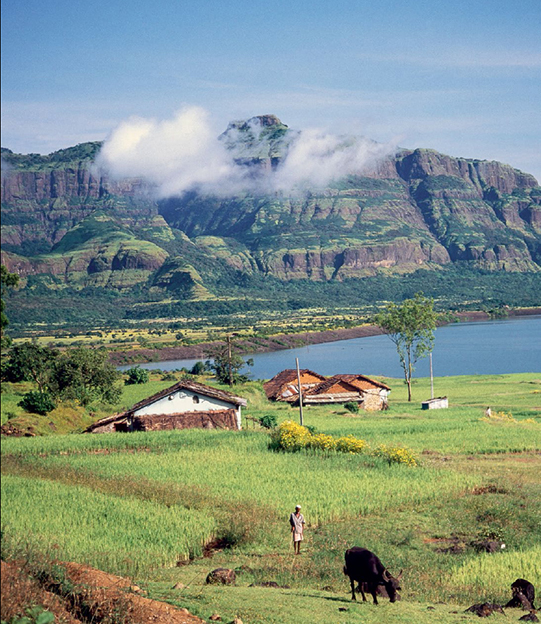c. 66 Million BCE
Deccan Traps
Many eighteenth- and nineteenth-century geologists were divided into two schools of thought. Gradualists thought changes in the Earth’s geology, biology, and climate came about slowly, over millennia to eons, for example via the action of slow plate motions or generations of natural selection. Catastrophists, however, thought change came in short, catastrophic bursts of activity associated with storms, volcanic eruptions, earthquakes, genetic mutations, or impact events. Arguments between the camps were intense. Today, though, modern geologists realize that major changes can actually come both ways.
Volcanic eruptions are examples of catastrophic events that can effect relatively sudden and dramatic changes to landscapes and climate. An impressive example comes from one of the largest episodes of volcanic activity in Earth’s history, an enormous outpouring of lava that erupted on the small continental plate of India as it was traveling (across what is now the Indian Ocean) toward a Himalaya-creating collision with the Eurasian plate. Over less than 50,000 years, lava flows spewed forth to eventually cover half the microcontinent to a thickness of more than 6,600 feet (2,000 meters).
The area covered by these voluminous lavas is called the Deccan Traps because of the stair-step nature of the thick layered lava flows (“deccan” from the Sanskrit “southern,” and “traps” from the Scandinavian word for stairs—“trappa”). A leading hypothesis for the origin of the Traps is that the Indian plate passed over and tapped into a hot mantle plume under the Indian Ocean, enabling huge volumes of magma to ascend to the surface.
In addition to molten rock, the volcanic outpouring also released enormous amounts of greenhouse gases. Another hypothesis thus links the Deccan Traps eruption to the mass extinction that occurred soon thereafter, at the end of the Cretaceous period (c. 65 million years ago). While this idea competes with the impact (followed by short-term climate change) hypothesis to explain the extinction of the ancient dinosaurs and many other species, in the spirit of the way the Gradualism–Catastrophism debate was resolved, many geologists and paleontologists are now more accepting of the idea that perhaps both near-simultaneous catastrophic events tipped the scales toward the mass extinction.
SEE ALSO Late Heavy Bombardment (c. 4.1 Billion BCE), Snowball Earth? (c. 720–635 Million BCE), The Great Dying (c. 252 Million BCE), Triassic Extinction (c. 200 Million BCE), Dinosaur-Killing Impact (c. 65 Million BCE), Arizona Impact (c. 50,000 BCE)
A pastoral landscape surrounded by layered volcanic hills in the Western Ghats Mountains in southern India—part of the large igneous province known as the Deccan Traps.
